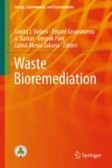Search
Search Results
-
Oxidation of bioreduced iron-bearing clay mineral triggers arsenic immobilization
Iron-bearing clay minerals and arsenic commonly coexist in soils and sediments. Redox oscillation from anoxic to oxic conditions can result in...

-
Bioremediation of Heavy Metals—Its Pros and Cons
Heavy metal pollution poses a substantial public health hazard, manifesting in diverse toxicological effects. Conventional remediation methods, while...
-
Mechanisms of Cr(VI) Reduction by Microorganisms
In nature, chromium exists in nine valence states with valences ranging from −2 to +6, however only Cr(III) and Cr(VI) are significantly important...
-
Fungal-Based Synthesis to Generate Nanoparticles for Nanobioremediation
Nanotechnology has gained immense popularity with its innumerable biological agents, which are replacing toxic chemicals with an advanced technique...
-
Enhanced bioreduction of nitrobenzene by reduced graphene oxide materials: effects of surface modification and coexisting soluble electron shuttles
Reduced graphene oxide (rGO) can enhance the bioreduction of nitrobenzene by Shewanella oneidensis MR-1. The effects of surface modification and...

-
Research progress and hotspots on microbial remediation of heavy metal-contaminated soil: a systematic review and future perspectives
Microbial remediation technology has received much attention as a green, ecological, and inexpensive technology, and there is great potential for the...

-
Removal of Dyes From Industrial Effluents Using Bioremediation Technique
Rapid growth in unstrategic development and industrialization over the few decades triggered the environmental problems worldwide. Synthetic dyes are...
-
Effective and reproducible biosynthesis of nanogold-composite catalyst for paracetamol oxidation
Pharmaceutical products are some of the most serious emergent pollutants in the environment, especially nowadays of the COVID-19 pandemic. In this...

-
Plant Material Assisted Magnetic Nanoparticles (MNPs) for the Separation of Inorganic Pollutants
Mainly Inorganic pollutants like heavy metals are generated from many industrial processes, agricultural activities and domestic sources. These...
-
Bioremediation of Heavy Metal Contaminated Sites Using Phytogenic Nanoparticles
Heavy metals (HMs) accumulate in milieu due to various human activities that persist leading to biomagnification in food chains and cause unpleasant...
-
Sustainable bioreduction of toxic levels of chromate in a denitrifying granular sludge reactor
Biological removal of chromate [Cr(VI)] in the presence or absence of nitrate by granular sludge biofilms was investigated in batch experiments and...

-
Green Synthesis of Nanoparticles: A Solution to Environmental Pollution
Recent development of nanotechnology led to the development of nanomaterials which pose potential hazards to health and the environment....
-
Biogenic synthesis of iron oxide nanoparticles using leaf extract of Spilanthes acmella: antioxidation potential and adsorptive removal of heavy metal ions
The sequestration of contaminants from wastewater, such as heavy metals, has become a major global issue. Multiple technologies have been developed...

-
The Response of Sarcodia suiae to Long-term Exposure of Arsenic (Arsenate): Growth, Morphology, and Arsenic Alterations
Long-term (20 days: 5 days interval) responses of Sarcodia suiae to high-tested As(V) concentration (125 and 250 μg L −1 ) under optimized condition...

-
Cr(VI) reduction by Agrobacterium sp. Cr-1 and Lysinibacillus sp. Cr-2, novel Cr(VI)-reducing strains isolated from chromium plant soil
The bioremediation of Cr(VI)-contaminated soil is a promising strategy; however, the performance of Cr(VI)-reducing bacteria is limited by the...

-
Microbial-driven ectopic uranium extraction with net electrical energy production
The extraction of uranium (U) from U-bearing wastewater is of paramount importance for mitigating negative environmental impacts and recovering U...

-
Bioreduction of Hexavalent Chromium Using Moderate Thermophilic and Thermophilic Microorganisms
Hexavalent chromium is one of the toxic heavy metals considered to be potentially harmful for life of a wide range of organisms, including human...
-
E-waste and Its Management by Using Algae
The presence of numerous potentially dangerous product components that can pollute the environmental surroundings and endanger the health of...
-
Microbes-Induced Biofabrication of Gold Nanoparticles and Its Exploitation in Biosensing of Phytopathogens
In the current arena of nanoscience and technology, the divergence from conventional chemical synthesis of nanoparticles has been fueled by the...
-
High-throughput Sequencing Analysis of the Effects of Vanadium on Bacterial Community Structure in Purple Soil
Vanadium (V) contamination in soil has received extensive attention due to its high toxicity. The change of mobility and bioavailability of soil V...

